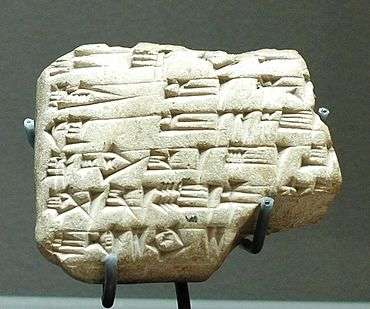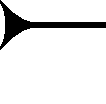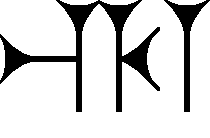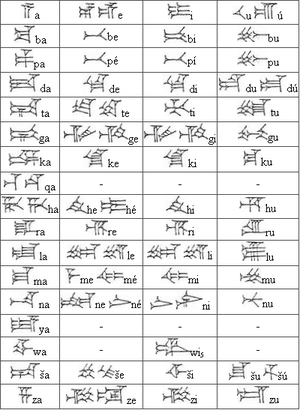Ù (cuneiform)
The cuneiform ù sign ('u, no. 3'), is found in both the 14th century BC Amarna letters and the Epic of Gilgamesh. Its use is as a conjunction, (translated as for example: and, but, else, until, etc.), but rarely it is substituted for alphabetic u, but that vowel u is typically represented by 'u, no. 2', (u prime), ú; occasionally 'u, no. 1', (u (cuneiform)),

Use of ù at start of Line 3-(directly below LUGAL-(king) of line 2).
Early 2nd millennium BC clay tablet of King Zimri-Lim of Mari.
| Wikimedia Commons has media related to Ù (cuneiform). |
| Wikimedia Commons has media related to Amarna letters. |
The use of ù is often as a "stand-alone" conjunction, for example between two listed items, but it is used especially as a segue in text, (example Amarna letters), when changing topics, or when inserting segue-pausing positions. In the Amarna letters, it is also commonly immediately followed by a preposition: a-na, or i-na, used as "...And, to....", or "...And, in...."; also "...But, for....", etc. This usage with a preposition is also a better example of the segue usage.
Of the three u's, by graphemic analysis (Buccellati, 1979), the commonness is as follows:[1]
- ù (cuneiform), conjunction only (but also rare, for alphabetic "u")
- ú (cuneiform), alphabetic 'u'
- u (cuneiform), alphabetic (minor), 10, conjunction (highest use)
Both "ù (cuneiform)" and ú are in the top 25 most used signs,[2] but E (cuneiform) and "u (cuneiform)" are not; other vowels (or combination) in the 25 are: a (cuneiform), i (cuneiform), and ia (cuneiform), (ia which has a secondary use as suffix, "-mine", or "my", thus in top 25 most used signs). Suffix "iYa" is used in the Middle East\Southwest Asia at present day to end placenames, or other names: "My Xxxxx".
Usage numbers of ù in the Epic of Gilgamesh is as follows: ù-(84);[3] Buccellati's usage numbers (330 Amarna letters) is (1848).[4]
Amarna letter varieties
Scribal variants of ù exist, and especially in the Amarna letters. At least one Amarna letter, EA 367, (Pharaoh to Endaruta), has an atypical variant, but the entire letter has somewhat unusual cuneiform signs. (gáb(káp)-(4 uses), tá, and a variant form of um) ("um" also =ṭup, also in the letter, for "clay tablet"-(tuppu), etc.)
- Cuneiform-Ù--(EA 367-scribe variant)---
Partial list of signs beginning with wedge (u)
Partial list of signs beginning with u-(wedge), from the Epic of Gilgamesh (Parpola, 1971), and the Amarna letters:
- Cuneiform-u--Sign No. 1---
- Cuneiform-AMAR, ṣur, zur--Sign No. 2---

- Cuneiform-di--Sign No. 3---
- Cuneiform-ki--Sign No. 4---
- Cuneiform-mi-(Sign 5)
- Cuneiform-ši--Sign No. 6---
- Cuneiform-ši, lim, or IGI ("in 'face' of", "before" Sumerogram)--Sign No. 6---
- Cuneiform-u--Sign No. u-1---
- Cuneiform-ú--Sign No. u-2---

- Cuneiform-ù-(u-3)--Sign No. 7---
- (With an added horizontal,

- (With an added horizontal,
Also:
- Cuneiform-ar, (Shuwardata of Amarna letter EA 282)
- Cuneiform-ar--

- Cuneiform-nim-(nem, nim, num, and Sumerograms NIM, NUM) (EA 34)
References
- Buccellati, Giorgio, (Ugarit-Forschungen 11, 1979). Comparative Graphemic Analysis of Old Babylonian and Western Akkadian, pp. 95-100, Graph, p. 96.
- Buccellati, (Ugarit-Forschungen 11, 1979). Comparative Graphemic Analysis of Old Babylonian and Western Akkadian, pp. 95-100, Graph, p. 96.
- Parpola, 197l. The Standard Babylonian Epic of Gilgamesh, Sign List, pp. 155-165, no. 455, p. 163.
- Buccellati, Giorgio, 1979, (Ugarit-Forschungen 11, 1979). Comparative Graphemic Analysis of Old Babylonian and Western Akkadian, pp. 95-100, Graph, p. 99.
- Parpola, 197l. The Standard Babylonian Epic of Gilgamesh, Glossary, pp. 119-145, amāru, p. 120.
- Buccellati, Giorgio, (Ugarit-Forschungen 11, 1979). Comparative Graphemic Analysis of Old Babylonian and Western Akkadian, pp. 95–100.
- Moran, William L. 1987, 1992. The Amarna Letters. Johns Hopkins University Press, 1987, 1992. 393 pages.(softcover, ISBN 0-8018-6715-0)
- Parpola, 197l. The Standard Babylonian Epic of Gilgamesh, Parpola, Simo, Neo-Assyrian Text Corpus Project, c 1997, Tablet I thru Tablet XII, Index of Names, Sign List, and Glossary-(pp. 119–145), 165 pages.
- Ugarit Forschungen (Neukirchen-Vluyn). UF-11 (1979) honors Claude Schaeffer, with about 100 articles in 900 pages. pp 95, ff, "Comparative Graphemic Analysis of Old Babylonian and Western Akkadian", author Giorgio Buccellati, ( i.e. Ugarit and Amarna (letters), three others, Mari, OB,Royal, OB,non-Royal letters).
|
|
